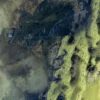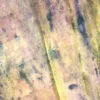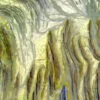There is something about the destruction which soon makes it feel uninteresting. Maybe because ruins by and large are similar, or maybe because without the people who once lived in them they are transformed into – literally – lifeless shells that all tell the same story. Even the landscape, Donetsk, seems to lose its meaning as we move through it: eternal curtains of trees; huge fields of dead, black sunflowers; identical (to the point of confusion) mountains of slag. Soon the monotony takes on a particular quality: in almost all villages, however badly damaged they may be (a column of white smoke from a chimney in the chill of the morning may be the only sign of life), you often catch sight of, first, an elderly woman wrapped in bundles of clothing, pushing a cart across a frozen dirt road, and, second, a couple of stray dogs skulking about in the ruins. It’s like standing in front of a cheap animation, the same images repeated over and over. But in a week or a month or three that same dying village can suddenly become important enough for people to die defending it.
The front line around Bakhmut is still more or less static, but hard battles are fought here. ‘But’ may be the wrong word, incidentally. The front line is static precisely because the battles are so violent, the Ukrainian defence so stubborn. The Russians attack again and again, most of them Wagnerites, mercenaries sometimes recruited from the prisons of Russia. ‘We call the people of the first wave donkeys,’ a Ukrainian soldier tells us. ‘They are completely green – no bulletproof vests, loaded with ammunition. The second and third wave pick up the ammunition. Then there’s the fourth and fifth wave. They are more experienced. And so it goes, wave after wave. The tenth or eleventh wave will take the house.’
The territorial gains are incomprehensibly minute if you count the cost in human life. The dead pile up (literally). The wounded who are not rescued freeze to death at night. A battle for a building can go on for days; a battle over a staircase can last for hours.
‘There are so many of them that we grow tired of killing.’
The front is closer now. There are fewer civilians on the village streets, and more soldiers in the Ukrainian army’s light brown uniform, with its digital camouflage pattern. The stretches between the roadblocks are shorter, the checks more thorough; there are ever more rusting wrecks by the side of the road. (In a ditch, a single tank turret, the object soldiers call a ‘lollipop’, because that’s what it looks like when the target explodes and the turret whirls up into the air.) Bridges over the icy rivers have long since been destroyed. We slow down; the road descends to a pontoon bridge, shaded by leaning concrete slabs.
The traffic now is almost exclusively military, vehicles of various kinds, most of them originally civilian, marked with white crosses. We are closer still. (Over there, an abandoned trench line filled with the detritus of war: bullet casings, empty cigarette packs, plastic bottles, Russian army supply boxes, parts of uniforms. Something – maybe a black balaclava? – hangs from a tree. Some fallen tree trunks look like a game of pick-up-sticks.)
We are there. Almost there. The frosty village street is empty. Any vehicles are either hidden or parked under a roof. (A recent wreck of a lorry shows us why.) We hear voices but see no one – the soldiers are hiding in one of the buildings that still has a roof. An armoured personnel carrier rattles by at great speed; the soldiers, in full combat gear, are crowded on top. One of them makes the shaka sign and smiles. Then they’re gone. What is termed the front is – emptiness. Visually speaking. It is, instead, a landscape made of sound: under your feet a carpet of noise, all around you a wall of cacophony, above you a sky of thunder.
They watch the sky anxiously as they work. It’s blue. But not summer blue or azure or clear blue – the sky is a cold blue, a metallic, cold blue. The only cloud you see is haze from missiles detonated over the Russian line. And earlier: a puff of white smoke with a wavy tail. A guided robot of some kind shot down another airborne entity of some kind, perhaps a Russian drone.
The men watch for these drones. They can see far on a day like this. Russian kamikaze drones target heavy equipment. And the Ukrainian equipment is undeniably heavy, and old – this howitzer is almost a museum object, inherited from the Soviet era, but it will have to do. The men haul it into position, watching the sky. They are in a hurry. The first shell is loaded. Someone has written a message on it: ‘From Igor for Dmytrivka’. It’s fired. At this proximity the sound and pressure waves are simultaneous. A yellow cloud of dust whirls up.
The field is flat, the horizon so distant as to feel eternal.
This is a war of artillery, an unexpected return to the shape of the First World War – and the Second – fought, not least, on this ground. These are the bloodlands, layer upon layer of battlefields and forgotten mass graves. ‘Artillery is the god of war,’ Stalin said, or may have said. The Soviet army used that tactic, and the Russian one after it. All resistance was to be annihilated by shells, hammered into the ground.
The Ukrainian army medic confirms the tactic: ‘I can’t give you exact figures, but about 90 per cent of all wounds are from explosives. The most common injuries are from the blast, and the pressure waves – burst eardrums, but often lungs are damaged too, and the inner organs, the guts. We give first aid to the wounded, stabilise them, then we drive them to the military hospital in town. Some of the badly wounded are transported all the way to Kharkiv. We see all kinds of injuries, terrible injuries.’
A question: Do you get used to it? Answer: ‘Most people get used to it in two weeks, maybe a month. After that it’s routine, a job to do. You learn not to engage emotionally. But sure, you can still feel it if you get someone to hospital and a few hours later he’s gone. We all feel it, and suffer from it, but to varying degrees and in different ways.’ The medic climbs back into his German military ambulance, engine running, red crosses painted out (‘The Russians target ambulances’).
A vast amount of ammunition is fired. During the great summer offensive of 2022, the Russian army fired some 50,000 shells a day; the Ukrainians some 7,000. (By comparison, the US produce around 15,000 a year.) By autumn, the Russian volume of fire decreased noticeably to about half the previous amount, a temporary reprieve. Both sides run out of ammunition from time to time, and (at least as important) the barrels of many Ukrainian artillery pieces are simply starting to wear out.
Artillery war is seldom described. It lacks dramatic quality: it’s monotonous. The protagonist can do little other than hide in a hole, hoping for luck. The antagonist is an invisible, untouchable force, far away. There is no combat, no one to outsmart, simply a collision between human beings and explosives. And explosives win, whenever they touch human beings. The end is not pretty. A grenade splinter as light as a gram can kill, almost without trace; a splinter of two grams can cut off a hand. A grenade exploding nearby can decapitate, shear off arms and legs, cut a person in two, turn a body inside out, transform it into a mix of guts and limbs, an empty sac of blackened skin, cut it into tiny pieces (the catalogue of obscenities ends here), turn it into vapour, make it disappear without trace.
Question: What do you do then? The military doctor who is the head of the medical station explains: ‘Sometimes we don’t even have a finger or a pair of legs to test for DNA. Then it’s a question for the courts. If the circumstances are known, and the person is gone, the court can declare death with a year’s delay from the day it happened. That’s routine. The ordinary deaths are worse. Like at New Year. That was particularly bad. It’s my task to document, to write death certificates, but also to photograph the bodies. Many of them were so young. Can you imagine sending a dead eighteen-year-old home, and only a part of the body is in the coffin?’
‘The two most important tools in this war,’ someone says, ‘are the drone and the spade.’ The drone to see what’s happening, the spade to dig a hideout. Digging the trenches was quick in this place – the trench is deep and narrow, as it should be. The men dug and hacked through a metre of fertile black soil to the light-grey Donbas clay underneath. Parts of the wall are secured with tree trunks and the ammunition is kept in a separate place, behind an earth blind. A thin layer of brush makes a roof, filtering the January sun. What took time, the group leader tells me, was the bunker. Two weeks.
A covered side tunnel leads to the bunker. The door is a coarse grey blanket. Behind it, down a few steps cut into the clay soil, is a room. The low ceiling is made of thick tree trunks, the floor is covered in canvas; the walls are clad in silver thermal blankets.
The air is stale, but it’s unexpectedly warm. There is a single lamp by the entrance, powered by a petrol generator which also provides electricity for chargers. On the right, a few planks on an ammo box makes a kitchen: sliced bread, teabags, instant coffee, a half-eaten orange, a white mug with the words you make my heart sing. (The word ‘sing’ is crossed out, replaced by ‘beat’.) On the floor some foam camping mats, sleeping bags and backpacks. Clothing, uniforms and carrier bags hang from nails on the walls. There’s a pair of green Crocs on the floor.
The place is in immaculate order. That’s true above ground, too. All rubbish is carefully collected, even cigarette ends, which are thrown into a bright-green Russian ammunition tin. The space has to be immaculate, otherwise six grown men couldn’t coexist in nine square metres underground.
Question: What is the worst thing about living in a bunker? Vasyl, thirty-five, used to work for a flooring company, and is married with two children: ‘It isn’t too bad. You get used to it. How long it takes depends on the person.’ Serhij, forty-eight, is a building engineer, divorced with an adult daughter: ‘Hygiene can be an issue, keeping clean. Rats and mice are a problem.’ Slava, fifty-one, previously unemployed, is unmarried: ‘It’s not frightening, but it’s harder at my age. The young ones support me.’
They have lived in this bunker for two months now. Earlier they were further south, on the Kherson front. These men have been fighting since the beginning of the war. Just one of them has had leave in the last two months. But they seem curiously unbothered. ‘We have to do this. We must defend ourselves.’ Dirty grey smoke rises from the horizon near Bakhmut as we speak.
The spades are piled by the side of the trench. The drone is up. The platoon commander, Robin, is twenty-four, a professional soldier with a girlfriend in Odesa. He bends over his iPhone in the trench, following the live feed from the drone. The phone is propped against a box; an ordinary tablet beside it is running the program that calculates the heavy mortar’s firing range. The drone is a civilian DJI Mavic 3. The battered old mortar, on the other hand, dates from the Soviet era.
They fire. Slava runs, carrying a bomb from the blind through the trench to the launcher. He holds the sixteen-kilogram object in front of him as you might hold a wet child. Robin wipes some dirt from the iPhone. The target is hard to hit. It’s a group of Wagnerites who have dug themselves into a slope, near a ruined house. Robin speaks to the drone pilot, watches the bombs explode in real time, corrects the aim, corrects again, fires. It’s a hit.
In one way, this sounds abstract, in another it’s all too real. On the high-res images captured by the drone you see what the bombs actually do. People collapse, crawl across the ground, writhe in pain. A dying man beats his left arm repeatedly into the crumpled ground. Seen on an iPhone it looks like a bizarre TikTok clip.
There are rumours about a great Russian offensive starting soon (someone calls it ‘the big show’) with regular troops, fresh brigades, new equipment – or at least only semi-aged. The Wagnerites are finished, some say literally so. It’s hard to get anyone to say much more. There is no excitement in the air, maybe because the men are used to living in a world of rumour, uncertainty and silence. Maybe because they have been fighting for so long, fighting even as the Russians arrived with their best troops, their latest tanks. Robin: ‘There is no war without loss, and this is far from over. But give us the tools and we’ll finish it.’
A slow, hesitant morning comes to life. The day is warming up. Someone puts out some sausage and water in a tin for the ginger cat. Medics crowd the farmyard, smoking. The atmosphere is one of nervous expectation. It’s over now, yesterday’s empty hours on the foam mats in the small house, windows covered and repaired, rooms heated by a wood-fired stove. It’s an unavoidable cliché: war is mainly waiting. Everyone waits for something or other; for orders or news or transport or for some imagined thing; waiting, at times without knowing why or what for; waiting impatiently or with boredom, with anxiety or without much reflection.
Yesterday the medics played with their phones or slept. But today something is happening at the zero line – the Ukrainian term for the front line. Something big. Everyone can hear it. I repeat: the landscape of war is an acoustic landscape. And sometimes sound is the only reliable information, the only one that does not underrepresent reality. The normal background noise of thunder and boom has tightened. We hear the drawn-out sound of a rocket salvo landing – WOMP WOMP WOMP WOMP WOMP WOMP – and so on. (Imagine forty such womps, one after the other, with a second or so in between: a deep, unpleasant sound you feel as much in your stomach as you do in your ears. It can make even seasoned veterans fall silent in the middle of a conversation, and turn their heads towards the sound as though out of respect.)
Soon it’s clear that tanks are involved, too. (The noise of tank fire is easily identifiable: BOOM–VOOM. The discharge is followed almost instantly by the sound of the hit.) Then the ripping sound of machine guns and automatic cannons rise through the clear and chilly air, indicating that the infantry has left the trenches and are moving through no man’s land.
This is the front west of Kreminna, a little town in the Luhansk region which the Ukrainians have been trying to recapture since late autumn, and which the Russians have defended energetically. The men talk about ‘the forest’ – no place names are mentioned – but everyone seems to understand anyway. Today the Ukrainians are attacking, again.
Military vehicles tear back and forth along the dusty village road. A drone is shot down from the blue leaving only a grey-white puff, soon dispersed by the wind. Someone says it’s not good to have so many vehicles parked close together. It draws the attention of the Russian drone pilots. But judging by the noise, all ambulances will be needed today: the military-green Dutch one, the boxy Danish one, the Norwegian one, so new it hasn’t been repainted yet, sygetransport still written on its side, and the all-terrain vehicle bought with private donations from Sweden. Walkie-talkies jump to life; shrill voices pour out.
The first transport of the day, a dusty black Nissan Warrior, stops in front of us. Three wounded men are assisted out: glassy eyes, grimaces, a bloody, swollen hand. But they can all walk to the waiting Norwegian ambulance. Next transport: a badly wounded man. The same glassy eyes, a bandaged head, a torn and bloodstained uniform. The alarm is sounded for three more casualties, then one more. The cat circles around broken glass and cigarette ends, sits down to lick her paws in the sun. The explosions seem not to concern her. It’s only when two jets pass over the roof, shooting rockets shaking the ground, that she is suddenly gone. The edge of the road is covered with the litter of earlier days: identity tape, bloody surgical gloves, an army hat with a hole in it, a camo glove on top of a crumpled golden trauma blanket.
Tinny radio voices announce ever more wounded soldiers. Now ten are coming, no, twelve, no, fifteen. A report comes in: a group of medics from another unit have hit a mine. In the forest. Shouts, questions – silence. No, no fatalities. Only light wounds. The thunder and bangs in all registers reach a crescendo. The Russians are counter-attacking, and the mood darkens.
The medics line up by the road, pull on fresh surgical gloves. Many injured men are coming. How many? ‘A lot.’ First a dark green all-terrain ambulance streaks past in a cloud of dust, then brakes, followed by a sand-coloured armoured personnel carrier stopping abruptly with a squeak. An unconscious man is carried away. A group of wounded men are helped out of the armoured vehicle and into waiting ambulances, which depart one by one.
A half-naked young man with dark hair and a short beard is left on the grass by the side of the road. His skin is pale, almost alabaster. On the right side of his chest you can see five or six tiny, jagged entry wounds. Grenade splinter. A female medic in camouflage and a protective vest finds a black body bag in the ambulance and unfolds it with a practised flick of the wrist. Her hair, put up, is coming loose. Her face is smeared with red – as it would be after giving a bleeding soldier mouth-to-mouth resuscitation.
One of the medics takes the feet of the dead man, two others take the arms. The body is manoeuvred into the sack. The medic closes the zip, crying quietly. The others have just lifted it up when an older soldier – short and sturdy with grey in his beard – runs up. He gesticulates, begs. After a short hesitation the men lower the bag to the ground. The medic zips it open and the fallen man’s face emerges in sharp profile, paler still against the black plastic – a pietà image. There is nothing frightening about the dead: they are just silent and pale and very still. All their pain and anxiety have been transferred to the living.
The older soldier kneels, touches the face of the dead man. ‘Vadym, Vadym!’ A group gathers. ‘My brother, don’t die!’ The medic kneels, speaks with him quietly, puts her arm around his shoulders. ‘Vadym, my brother!’ Two others help the man to his feet, gently lead him away. He has blood on his face, his features have somehow dissolved, his eyes are staring, unseeing. The body bag is carried away. When all the wounded have been driven off one of the medics brings out a bucket of hot water. They scrub out the ambulance. Red water runs down the road, staining the frozen sand. The medic has stopped crying. Her face is clean, her expression is resolute and she has rearranged her hair.


Sign in to Granta.com.








